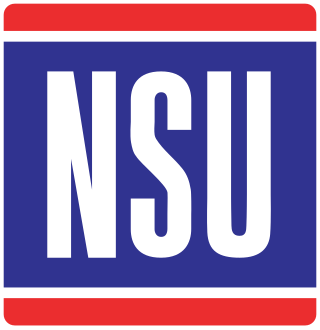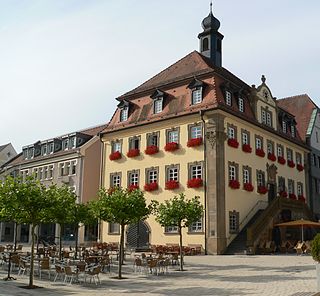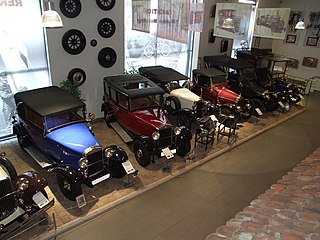
A motorcycle is a two or three-wheeled motor vehicle steered by a handlebar from a saddle-style seat.

Auto UnionAG was an amalgamation of four German automobile manufacturers, founded in 1932 and established in 1936 in Chemnitz, Saxony. It is the immediate predecessor of Audi as it is known today.

The NSU Ro 80 is a four-door, front-engine executive sedan manufactured and marketed by the West German firm NSU from 1967 until 1977.

NSU Motorenwerke AG, or NSU, was a German manufacturer of automobiles, motorcycles and pedal cycles, founded in 1873. Acquired by Volkswagen Group in 1969, VW merged NSU with Auto Union, creating Audi NSU Auto Union AG, ultimately Audi. The NSU name is an abbreviation of "Neckarsulm Strickmaschinen Union".

The Sd.Kfz.2 is a half-track motorcycle with a single front wheel, better known as the Kleines Kettenkraftrad HK 101, shortened to Kettenkrad. It was used by the military of Nazi Germany during the Second World War.
This timeline of motorized bicycle history is a summary of the major events in the development and use of motorized bicycles and tricycles, which are defined as pedal cycles with motor assistance but which can be powered by pedals alone.

The Hildebrand & Wolfmüller was the world's first production motorcycle. Heinrich and Wilhelm Hildebrand were steam-engine engineers before they teamed up with Alois Wolfmüller to produce their internal combustion Motorrad in Munich in 1894.

Neckarsulm is a city in northern Baden-Württemberg, Germany, near Heilbronn, and part of the district of Heilbronn. As of 2016, Neckarsulm had 26,800 inhabitants. The name Neckarsulm derives from the city's location where the Neckar and Sulm rivers meet.

The Mittlerer Ladungsträger Springer was a demolition vehicle of the German Wehrmacht in World War II.
The history of the motorcycle begins in the second half of the 19th century. Motorcycles are descended from the "safety bicycle," a bicycle with front and rear wheels of the same size and a pedal crank mechanism to drive the rear wheel. Despite some early landmarks in its development, the motorcycle lacks a rigid pedigree that can be traced back to a single idea or machine. Instead, the idea seems to have occurred to numerous engineers and inventors around Europe at around the same time.
Rheinmetall Automotive is the Automotive sector of the parent group Rheinmetall. The company emerged in 1997 through the merger of KS Kolbenschmidt GmbH, Neckarsulm, and Pierburg GmbH, Neuss. Hence, at its various traditional locations the company is commonly known as Kolbenschmidt or Pierburg. 40 production plants in Europe, the Americas, Japan, India and China employ a total workforce of around 11,000. Products are developed in cooperation with international auto manufacturers. Rheinmetall Automotive ranks among the 100 biggest auto industry suppliers worldwide and is an important partner to the industry for such products as exhaust gas recirculation systems, secondary-air systems, coolant pumps, and pistons for car gasoline engines and as well as for the commercial vehicle sector.

Museum Autovision is a museum for cars, motorcycles, bicycles in Altlußheim, a small town in Baden-Württemberg, Germany.

Victoria was a bicycle manufacturer in Nürnberg, Germany that made motorcycles from about 1901 until 1966. It should not be confused with a lesser-known, unrelated Victoria Motorcycle Company in Glasgow, Scotland that made motorcycles between 1902 and 1928.

The Dresden Transport Museum displays vehicles of all modes of transport, such as railway, shipping, road and air traffic, under one roof.

The NSU Quick 50 was a light motorcycle manufactured by NSU Motorenwerke AG. NSU started producing the Quick 50 in Neckarsulm, Germany in 1962. 9,323 Quick 50 motorcycles were built before NSU stopped manufacturing motorcycles in 1965. Having produced bikes and automobiles since 1873, NSU was purchased by Volkswagen and was merged with Auto Union in 1969 to create Audi. To this day NSU bikes are sought as collectors' pieces, and for some still serve as functioning modes of transportation.

The NSU Typ 110 is a small car that was made by NSU between 1965 and 1972. It was first presented at the 1965 Frankfurt Motor Show, widening NSU's range in the process. It was based on the NSU Prinz 1000 but with a longer wheelbase and a front overhang which increased available space both in the passenger cabin and in the luggage compartment. With an external length of four metres the car took NSU into the lower rungs of the middle class saloon sector, as it existed at that time in West Germany. It was to distance the model from the small car sector that for this model NSU abandoned the Prinz name which had till then been carried by their passenger cars.

The Daimler Reitwagen or Einspur was a motor vehicle made by Gottlieb Daimler and Wilhelm Maybach in 1885. It is widely recognized as the first motorcycle. Daimler is often called "the father of the motorcycle" for this invention. Even when the steam powered two-wheelers that preceded the Reitwagen, the Michaux-Perreaux and Roper of 1867–1869, and the 1884 Copeland, are considered motorcycles, it remains nonetheless the first gasoline internal combustion motorcycle, and the forerunner of all vehicles, land, sea and air, that use its overwhelmingly popular engine type.

The Hercules W-2000 is a motorcycle which was made by Hercules in Germany. It was the first production motorcycle with a Wankel engine.

The Audi Forum Ingolstadt is a building complex owned by Audi AG, located at their largest operation center in Ingolstadt. On 15 December 2000, the Audi Forum Ingolstadt was opened. Located on the site are meeting rooms, a customer center, Audi museum mobile, varying exhibitions, restaurants, and an art house cinema. The Forum has about 400,000 visitors yearly.



















